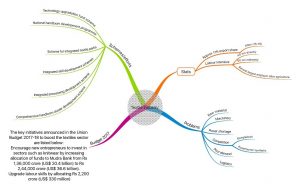IASbaba's Think Learn and Perform 2017, UPSC Mains Answer Writing
SYNOPSIS- IASbaba’s TLP 2017 [21st March] – Day 46
ARCHIVES
1. India used to have a sustainable and efficient agricultural system in place which was replaced by a more productive but unsustainable form of cultivation. Now the impetus has again shifted to traditional knowledge and local wisdom. What strategy would you suggest to make this shift successful. Discuss.
Introduction:
Write a brief introduction.
Body:
Strategy for using traditional knowledge and wisdom to make agriculture sustainable:
1. The second green revolution emphasis on using organic fertilizer. But the sector suffers from lack of regulation and financial support. Providing the institutional credit and physical infrastructure for research in organic sector with proper regulating policy is needed. Further making the organic products affordable is imperative.
2. The wells served the need of the land from ancient to modern times. There is inadequate support from governmentt to traditional way of irrigation waters. There should be policy shift as this water storing method has potential to include marginal farmers and affordable as compared to electric pump sets and bore-wells.
3. Local wisdom should be given modern digital touch to see efficiency and efficacy. Kisan call centres and Krishi Vigyan KEndras should promote local techniques with modern ideas as their complimentary.
4. Awareness among people to go sustainable as should be achieved through vigorous campaigning.
5. Efficient irrigation facility like drip irrigation should be used in place of traditional practices, this helps to reduces soil salinity and will enhance productivity
6. Full exploitation of Parampargat krishi vikash yojna.Aware farmers about it so that they can start natural, organic farming
Conclusion:
Write a brief conclusion.
Best answer: PD
2. Decentralised irrigation techniques must take precedence over large dams and reservoirs keeping in mind India’s unique landscape and special agricultural needs.
Introduction:
Write a short introduction.
Body:
o Need for Decentralized irrigation systems:
1. Loss of habitat and biodiversity: many wild animals and exotic animals have lost their habitats due to large scale inundation caused by the large dams.
2. Many local communities have lost their traditional communities and culture, their native agro practices and water conservation techniques have been ignored.
3. One size fits all approach has led to mono-culturing, even in the unsuitable areas, free supply of water and electricity have destroyed the soils.
4. Decentralized agriculture and water management techniques will allow for better use of water and keep the habitations intact.
5. Decentralized agriculture and irrigation planning will engage the local people better in terms of collection of data, assessing water demands and sustainable solution for them.
6. Locally innovative and sustainable ideas can be replicated in areas with similar characteristics, which will reduce the costs.
7. Local communities will get employment as the techniques spead to other areas, and new and novel ideas will spread further.
Conclusion:
Write a short conclusion.
Best answer: Putta
3. The sense of service associated with the job of a bureaucrat makes him more responsive and responsible. Comment.
This is a pretty straight forward question which asks you to tell why bureaucracy is a service and not a job.
To add more impact to your answer, you can put some quotes of Indian and foreign thinkers.
The sense of service should come as a part of work ethics. Once a person get to that position of responsibility and get to work in the field, he meet new people and face several challenges. This makes him more responsive to the need of people and he can actually empathise with them.
The best answer here has covered all the aspects of this question very nicely, so there is nothing much to mention now in the synopsis.
Best Answer: Arthanari
https://uploads.disquscdn.com/images/a66c0b3388b2bcf7be9add34d59858611d3049e3ad3b0716846c7d532089232b.jpg
https://uploads.disquscdn.com/images/427d080a678e8a13aab04eee67b59901844b2b7b45dd49fd4682e35aa5e9f5ba.jpg
4. The culture of settling disputes amicably outside the courtrooms is the need of the hour in India. Comment

Best Answer: Axi tak
5. Why textile sector remains an ailing sector in India? Analyse.

Best Answer: Oolong Slayer IPS
India held world monopoly in the manufacturing of cotton textiles for about 3,000 years from about B.C. 1500 to A.D. 1500. In the middle ages, Indian cotton textile products were in great demand in the Eastern and European markets. But today this industry faces a lot of problems.
Problems of Indian Textile Industry:
1. SCARCITY OF RAW MATERIAL: Although much headway has been made to improve the production of raw cotton, its supply has always fallen short of the demand. Much of the long staple cotton requirements are met by resorting to imports.
2. OBSOLETE MACHINERY: Most of the textile mills are old with obsolete machinery. This results in low productivity and inferior quality. Only 18-20 per cent of the looms in India are automatic.
3. ERRATIC POWER SUPPLY: Power supply to most cotton textile mills is erratic and inadequate which adversely affects the production.
4. LOW PRODUCTIVITY: Labour productivity in India is extremely low. On an average a worker in India handles about 2 looms as compared to 30 looms in Japan and 60 looms in the USA.
5. STRIKES: Labour strikes are common in the industrial sector but cotton textile industry suffers a lot due to frequent strikes by a labour force.
6. STIFF COMPETITION: Indian textile industry has to face stiff competition from products of other countries which are cheaper. Eg Chinese textile goods.
7. SICK MILLS: The above factors acting singly or in association with one another have resulted in many sick mills. As many as 177 mills have been declared as sick mills. 483 mills have already been closed.
Textile industry has several challenges ahead and re-orientation of the industry, both organic and systemic, is required to enhance its competitive strength and improve its global positioning in the new millennium, so that the industry achieves cost reduction, attains quantum jump in quality production and improves delivery systems.













